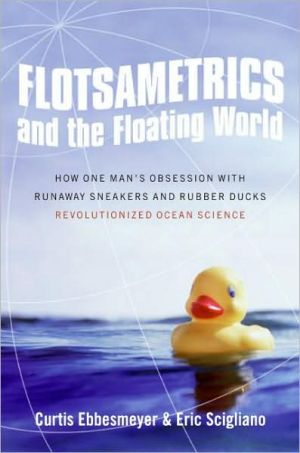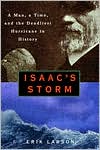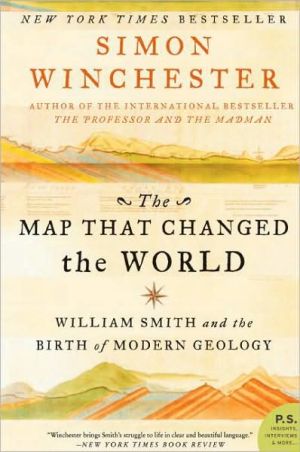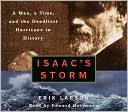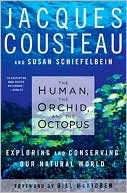Flotsametrics and the Floating World: How One Man's Obsession with Runaway Sneakers and Rubber Ducks Revolutionized Ocean Science
Pioneering oceanographer Curtis Ebbesmeyer seized the world's imagination when he and his worldwide network of beachcomber volunteers traced ocean currents using thousands of sneakers and plastic bath toys spilled from storm-tossed freighters. Now, for the first time, Ebbesmeyer tells the story of his lifelong quest to solve the sea's mysteries. He recounts how flotsam has changed the course of history. He reveals the rhythmic and harmonic order in the vast oceanic currents and uncovers the...
Search in google:
Pioneering oceanographer Curtis Ebbesmeyer seized the world's imagination when he and his worldwide network of beachcomber volunteers traced ocean currents using thousands of sneakers and plastic bath toys spilled from storm-tossed freighters. Now, for the first time, Ebbesmeyer tells the story of his lifelong quest to solve the sea's mysteries. He recounts how flotsam has changed the course of history. He reveals the rhythmic and harmonic order in the vast oceanic currents and uncovers the astonishing story of flotsam, altering the world's view of trash, the ocean, and our global environment. Publishers Weekly Part oceanography lesson, part memoir, this cheerful book examines Ebbesmeyer's life and work as a pioneering oceanographer (the first to work for Mobil/Standard Oil, in 1969) and connoisseur of beach-combed artifacts. His primary interest is ocean currents, especially gyres-great circular, interlocking currents that sweep the Earth's waters with clockwork regularity-and the flotsam they carry around the planet. Everything from athletic shoes and bathtub toys to messages in bottles and corpses have provided data to help Ebbesmeyer trace currents. He recounts how flotsam guided colonization and exploration, from Norse explorers to Christopher Columbus (the first to master the North Atlantic Subtropical Gyre). Today, Ebbesmeyer says, the human propensity for creating garbage has also made flotsam an environmental concern, with too many studies "neatly filed away and forgotten." This account, made lively with the help of journalist Scigliano (Puget Sound), might encourage many readers to dream of "roundi[ng] the gyres" like Ebbesmeyer, "searching out the world's trashiest beaches." Illus. (Apr.)Copyright © Reed Business Information, a division of Reed Elsevier Inc. All rights reserved.
Flotsametrics and the Floating World\ How One Man's Obsession with Runaway Sneakers and Rubber Ducks Revolutionized Ocean Science \ \ By Curtis Ebbesmeyer Eric Scigliano \ Smithsonian\ Copyright © 2009 Curtis Ebbesmeyer, Eric Scigliano\ All right reserved.\ ISBN: 978-0-06-155841-2 \ \ \ Chapter One\ Chasing Water \ I was a penniless, uneducated man. A piece of driftwood. -Abraham Lincoln\ In the wee hours of May 27, 1990, midway between Seoul and Seattle, the freighter Hansa Carrier met a sudden storm and, as freighters often do, lost some of the cargo lashed high atop her deck. Twenty-one steel containers, each forty feet long, tore loose and plunged into the North Pacific. Five of those containers held high-priced Nike sports shoes bound for the basketball courts and city streets of America. One sank to the sea floor. Four broke open, spilling 61,820 shoes into the sea-and into the vast stream of flotsam, containing everything from sex toys to computer monitors, that is released each year by up to ten thousand overturned shipping containers.\ One year later, in early June 1991, I stopped by my parents' house in Seattle, as I did every week or so, for lunch and the latest news. My mother, who loved serving as my personal clipping service, had extracted a wire story from the local paper. It reported a strange phenomenon: Hundreds of Nike sneakers, brand-new save for some seaweed andbarnacles, were washing up along the Pacific coasts of British Columbia, Washington, and, especially, Oregon, Nike's home state. A lively market had developed; beach dwellers held swap meets to assemble matching pairs of the remarkably wearable shoes, laundered and bleached to remove the sea's traces. The details as to how they'd gotten there were sketchy, verging on nonexistent, and that piqued my mother's curiosity. "Isn't this the sort of thing you study?" she asked, assuming as ever that her son the oceanographer knew everything about the sea. "I'll look into it," I said.\ I started looking and never stopped. Seventeen years and many thousands of shoes, bath toys, hockey gloves, human corpses, ancient treasures, and other floating objects later, I'm still looking.\ Objects like these have been falling into the sea and washing up on the shores since the dawn of navigation-for billions of years, if you count driftwood, volcanic pumice, and all the other natural materials that float upon the waves. Ordinarily, flotsam is soon lost to human memory-though not, as we shall see, to the ocean's memory. The Great Sneaker Spill would have proved one more curiosity in the annals of beachcombing if my mother hadn't asked her question, and if I hadn't been ready to see the research doors that it opened.\ It's only now that I can see how my entire life-from my first childhood encounters with the sea to decades of mainstream research into currents, tides, drifting pollutants, and the curious mobile water bodies called slabs-had prepared me for the puzzle posed by this spill. These thousands of lost sneakers composed a giant scientific experiment on a silver platter, fully if unwittingly funded by Nike-a serendipitous window into the ocean's deepest secrets. They were also the grain around which a worldwide network of beachcombing field volunteers has formed, zealously scouting out and recording telltale washups from Norway to New Zealand.\ These high-seas drifters offer a new way of looking at the seas, their movements, and, as we shall see, their music. Call it "flotsametrics." It's led me to a world of beauty, order, and peril I could not have imagined even after decades as a working oceanographer-the floating world.\ I did not grow up beside the sea; we lived across the San Rafael Mountains in the hot and dusty San Fernando Valley. My mother and father were raised in Chicago and never saw the ocean until the war brought them to California in 1941. But we were close enough to the water to pine for it-and to escape to the beach whenever we had a free day. Perhaps being so near and yet cut off from the sea made me crave it all the more.\ As far back as I can remember, I was fascinated with water and its movements. As soon as I could get my hands on a garden hose, I stuck it in the ground and watched the soil bubble up and wash away around it, like sand on a beach. I would make a pond out of my red Radio Flyer wagon, filling it with water and setting toys and beer bottles floating across it. In elementary school I wrote a story about Paul Bunyan but recast him as a giant of the ocean rather than the woods, striding from sea to sea in his seven-league boots.\ My father was a chocolate salesman. Perhaps this followed from his mother's career back in Chicago-making bootleg whiskey, a trade she learned growing up on an Iowa farm and then used to see her children through the Depression after her husband died as the result of an industrial accident. Dad's stock-in-trade was a fine German chocolate brand named Merckens. Twice a month he drove up the coast from Los Angeles to San Francisco teaching small candy shops along the way how to dip conventional American chocolates in melted Merckens. He was a natural at such performances-tall and mirthful, with hair turned a distinguished premature white by all the ether he'd been administered as a teenager during operations on a badly broken ankle. He was a born starter-upper, always organizing projects when he got home-a go-kart for us, new trees for the yard, a block wall around our entire half-acre lot.\ Dad's sales trips usually lasted a week, and after each he brought home presents for my brother Scott and me. One Easter, when I was about ten years old, he brought two yellow ducklings. With characteristic whimsy, he named them Flotsam and Jetsam, names that would stay with me for the rest of my life. No one could have guessed how prophetic that gift would prove to be.\ Even Dad's chocolate trade seems in retrospect to have forecast the path I would take. The Western world's first chocolate salesman was Christopher Columbus, who brought Europe its first cacao beans when he returned from America. And it was flotsam that led Columbus to America in the first place.\ (Continues...)\ \ \ \ \ Excerpted from Flotsametrics and the Floating World by Curtis Ebbesmeyer Eric Scigliano Copyright © 2009 by Curtis Ebbesmeyer, Eric Scigliano. Excerpted by permission.\ All rights reserved. No part of this excerpt may be reproduced or reprinted without permission in writing from the publisher.\ Excerpts are provided by Dial-A-Book Inc. solely for the personal use of visitors to this web site. \ \
\ Booklist“With a whimsical mood overlaying serious science, Ebbesmeyer’s work will appeal to the environmentally minded.”\ \ \ \ \ The Guardian“As much genial personal memoir as pop-oceanography exposition…When science goes right, we discover how mid-ocean spills of hockey gloves or rubber ducks enhance oceanographic understanding;\ \ \ Publishers WeeklyPart oceanography lesson, part memoir, this cheerful book examines Ebbesmeyer's life and work as a pioneering oceanographer (the first to work for Mobil/Standard Oil, in 1969) and connoisseur of beach-combed artifacts. His primary interest is ocean currents, especially gyres-great circular, interlocking currents that sweep the Earth's waters with clockwork regularity-and the flotsam they carry around the planet. Everything from athletic shoes and bathtub toys to messages in bottles and corpses have provided data to help Ebbesmeyer trace currents. He recounts how flotsam guided colonization and exploration, from Norse explorers to Christopher Columbus (the first to master the North Atlantic Subtropical Gyre). Today, Ebbesmeyer says, the human propensity for creating garbage has also made flotsam an environmental concern, with too many studies "neatly filed away and forgotten." This account, made lively with the help of journalist Scigliano (Puget Sound), might encourage many readers to dream of "roundi[ng] the gyres" like Ebbesmeyer, "searching out the world's trashiest beaches." Illus. (Apr.)\ Copyright © Reed Business Information, a division of Reed Elsevier Inc. All rights reserved.\ \ \ \ \ Kirkus ReviewsLively as-told-to autobiography of a scientist who studied flotsam-floating trash-and revolutionized the study of the world's oceans. Ebbesmeyer graduated college as a mechanical engineer in the mid-1960s and went to work for Mobil/Standard Oil, which financed the doctorate studies that made him the company's first oceanographer. Years of traveling the world gave him an intimate knowledge of how ocean movements affect oil rigs, but he grew increasingly fascinated by sea currents and eddies and began to focus on beaches, more specifically on debris deposited there. An epiphany came in May 1990 when a Pacific storm knocked five containers filled with thousands of athletic shoes off a cargo vessel. Nearly a year later, the shoes began washing up along the West coast of North America. With the help of a surprisingly large and cooperative fraternity of beachcombers, Ebbesmeyer tracked the progress of the shoes up and down the coast and as far as Hawaii, producing a groundbreaking study of ocean currents. With the help of maritime and environmental journalist Scigliano (Michelangelo's Mountain: The Quest for Perfection in the Marble Quarries of Carrara, 2005, etc.), Ebbesmeyer spins a fascinating tale. Even readers with little interest in ocean science will be riveted by the author's chronicle of the epic travels of oceanic trash; the entertaining explanations of how floating debris guided Christopher Columbus and the Vikings to safe harbors; the horrific stories of men adrift at sea; how flotsam may have triggered the origin of life; and frighteningly, the warnings of the threat that an increasing avalanche of plastic waste poses to the oceans. A captivating account of the man who turnedbeachcombing into a science. Author appearances in Seattle\ \ \ \ \ Natural History magazine“Light and lively...Shoes, messages in bottles, and floating rubber ducks have kept Ebbesmeyer’s eye on the big picture. Besides, as readers will readily agree, they’ve been a lot of fun to study.”\ \ \ \ \ Booklist"With a whimsical mood overlaying serious science, Ebbesmeyer’s work will appeal to the environmentally minded."\ \ \ \ \ The Guardian"As much genial personal memoir as pop-oceanography exposition…When science goes right, we discover how mid-ocean spills of hockey gloves or rubber ducks enhance oceanographic understanding;\ \ \ \ \ NatureWhether you want to learn more about how the oceans tick or how we are affecting our environment, or to reminisce about science not being what it used to be, this is a very enjoyable, if at times dark, book.\ \ \ \ \ Natural History Magazine"Light and lively...Shoes, messages in bottles, and floating rubber ducks have kept Ebbesmeyer’s eye on the big picture. Besides, as readers will readily agree, they’ve been a lot of fun to study."\ \
